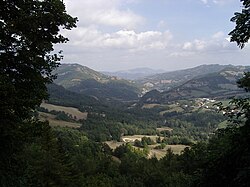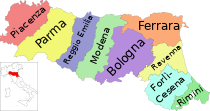Province of Rimini
Province of Rimini
Provincia di Rimini (Italian) | |
|---|---|
 | |
 Map highlighting the location of the province of Rimini in Italy | |
| Country | |
| Region | Emilia-Romagna |
| Capital(s) | Rimini |
| Comuni | 27 |
| Government | |
| • President | Jamil Sadegholvaad |
| Area | |
• Total | 921.77 km2 (355.90 sq mi) |
| Population (31 January 2022)[1] | |
• Total | 339,169 |
| • Density | 370/km2 (950/sq mi) |
| GDP | |
| • Total | €9.489 billion (2015) |
| • Per capita | €28,297 (2015) |
| Time zone | UTC+1 (CET) |
| • Summer (DST) | UTC+2 (CEST) |
| Postal code | 47811–47814, 47821–47828, 47831–47838, 47841–47843, 47851–47855, 47900 |
| Telephone prefix | 0541, 0722 |
| Vehicle registration | RN |
| ISTAT | 099 |

The province of Rimini (Italian: provincia di Rimini) is the southernmost province of the Emilia-Romagna region of Italy. Its capital is the city of Rimini, one of the "seven sisters" of the historical region of Romagna.
The province borders the Adriatic Sea to its northeast, the province of Forlì-Cesena to its northwest, the province of Pesaro and Urbino, in the Marche region, to its south and southeast, the independent Republic of San Marino to its south, and the province of Arezzo in Tuscany to its southwest.
The province consists of 27 comuni (sg.: comune), centred on the valleys of the Marecchia and Conca rivers. Since the transfer of nine comuni (municipalities) from Pesaro and Urbino in 2009 and 2021, the province of Rimini includes most of the historical region of Montefeltro.
History
[edit]The province of Rimini was formed on 16 April 1992. Its comuni were previously part of the province of Forlì, whose remaining part was renamed the province of Forlì-Cesena.[3]
On 1 January 1996, the comuni of Gemmano, Montefiore Conca, Saludecio, Mondaino, Montegridolfo, Montescudo, Monte Colombo, San Clemente, and Morciano di Romagna formed the Valconca Union. The union was formed to integrate public services across the comuni. A clause working towards the comuni's merger was repealed in 2009.[4]
On 15 August 2009, seven comuni were transferred from the province of Pesaro and Urbino, in the Marche region, to the province of Rimini. The comuni were Casteldelci, Maiolo, Novafeltria, Pennabilli, San Leo, Sant'Agata Feltria and Talamello.[5]
On 1 January 2016, Montescudo and Monte Colombo were merged into a single comune, Montescudo-Monte Colombo.[6]
On 16 October 2016, a merger of the comune of Montegridolfo, Mondaino and Saludecio was rejected at referendum. Montegridolfo and Mondaino voted 92.9% and 69.5% for the merger, but Saludecio voted 58.2% against.[4]
On 17 June 2021, the comuni of Montecopiolo and Sassofeltrio were transferred from the province of Pesaro and Urbino to the province of Rimini.[7]
Constituent comuni
[edit]Twenty-seven comuni (municipalities) constitute the province of Rimini:
- The five coastal comuni, from northwest to southeast, are Bellaria-Igea Marina, Rimini, Riccione, Misano Adriatico, and Cattolica.
- Southeast of San Marino are the comuni of Coriano, Montescudo-Monte Colombo, Sassofeltrio, Gemmano, San Clemente, Morciano di Romagna, Montefiore Conca, Saludecio, San Giovanni in Marignano, Montegridolfo, and Mondaino. These comuni are centred on the valley of the Conca river, and are sometimes referred to as the Valconca comuni.[4] Sassofeltrio was transferred from the province of Pesaro and Urbino to the province of Rimini on 17 June 2021.[7]
- North and northwest of San Marino are the comuni of Santarcangelo di Romagna, Poggio Torriana and Verucchio. These three comuni are centred on the lower valley of the Marecchia river.
- West and southwest of San Marino are the comuni of Novafeltria, San Leo, Talamello, Maiolo, Sant'Agata Feltria, Pennabilli, Casteldelci, and Montecopiolo. With the exception of Montecopiolo, these seven comuni collectively constitute the Alta-Marecchia region, and were transferred from the province of Pesaro and Urbino to the province of Rimini on 15 August 2009.[5] Montecopiolo, on the river Conca, was transferred on 17 June 2021.[7]
Government
[edit]| President | Term start | Term end | Party | |
|---|---|---|---|---|
| Ermanno Vichi | 8 May 1995 | 28 June 1999 | Ulivo | |
| Ferdinando Fabbri | 28 June 1999 | 22 June 2009 | DS/PD | |
| Stefano Vitali | 23 June 2009 | 13 October 2014 | PD | |
| Andrea Gnassi | 13 October 2014 | 30 October 2018 | PD | |
| Riziero Santi | 31 October 2018 | 24 November 2022 | PD | |
| Jamil Sadegholvaad | 24 November 2022 | incumbent | PD | |
References
[edit]- ^ Dato Istat - population as of 31 May 2019
- ^ Regions and Cities > Regional Statistics > Regional Economy > Regional Gross Domestic Product (Small regions TL3), OECD.Stats. Accessed on 16 November 2018.
- ^ "Decreto Legislativo 6 marzo 1992, n. 252" [Legislative Decree 6 March 1992, no. 252]. Gazzetta Ufficiale (in Italian). 6 March 1992. Retrieved 2 January 2024.
- ^ a b c Zaghini, Paolo (16 October 2023). "Sulle rive del Conca, confine che unisce" [On the banks of the Conca, a border that unites]. Chiamami Città (in Italian). Retrieved 2 January 2024.
- ^ a b "Legge 3 agosto 2009, n. 117" [Law of 3 August 2009, no. 117]. Italian Parliament (in Italian). 3 August 2009. Retrieved 2 January 2024.
- ^ "n.305 del 23.11.2015 (Parte Prima)". Official Bulletin of the Emilia-Romagna Region (in Italian). 23 November 2015. Retrieved 2 January 2024.
- ^ a b c "Legge 28 maggio 2021, n. 84" [Law of 28 May 2021, no. 84]. Gazzetta Ufficiale (in Italian). 28 May 2021. Retrieved 2 January 2024.
External links
[edit]- Official website (in Italian)



